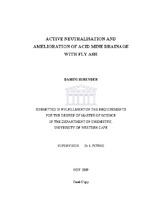| dc.contributor.advisor | Petrik, Leslie | |
| dc.contributor.author | Surender, Damini | |
| dc.contributor.other | Faculty of Science | |
| dc.date.accessioned | 2014-01-27T12:47:38Z | |
| dc.date.available | 2011/02/11 11:21 | |
| dc.date.available | 2011/02/11 | |
| dc.date.available | 2014-01-27T12:47:38Z | |
| dc.date.issued | 2009 | |
| dc.identifier.uri | http://hdl.handle.net/11394/2651 | |
| dc.description | Magister Scientiae - MSc (Dept. of Chemistry) | en_US |
| dc.description.abstract | Fly ash and AMD samples were characterised by standard analytical methods for selection of the test materials. Active treatment by means of mixing fly ash with AMD in beakers and a large tank at pre-determined ratios have shown that fly ash is capable of neutralising AMD and increasing the pH beyond neutral values, which optimises the removal of heavy metals and ions. The trend was: the more fly ash added the quicker was the reaction time and higher the pH values achieved. Iron was reduced by as much 99 % in beaker scale experiments via Fe(OH)3 precipitation at pH values >4.0. A 99 % decrease in aluminium concentration was observed which was attributed to the precipitation of primarily gibbsite and various other mineral phases at pH values >5.5. As the pH increases, sulphate is adsorbed via Fe(OH)3 and gypsum precipitation at elevated pH. Sulphate attenuation with fly ash was excellent, achieving 98 % attenuation with beaker scale experiments and 1:1 fly ash:AMD ratio. Sulphate attenuation with fly ash was comparable to membrane and ion exchange systems and exceeded the performance of limestone treatment. Except for the larger volumes of fly ash needed to neutralise the AMD, fly ash proved to be a feasible and cost efficient alternative to limestone treatment. Fly ash produced competing results to limestone concerning acidity removal and sulphate attenuation. The comparison highlighted the advantages of utilising fly ash in comparison to limestone and demonstrated its cost effectiveness. The results of this study have shown that fly ash could be successfully applied for the neutralisation of acid mine drainage (AMD) and effectively attenuate the sulphate load in the treated water. The critical parameters to this technology are the variations of chemical composition and mineralogy of fly ash, which could influence the pH, contact time of the neutralisation reaction, and the same is true if the AMD quality varies. | en_US |
| dc.language.iso | en | en_US |
| dc.publisher | University of the Western Cape | en_US |
| dc.subject | Acid mine drainage | en_US |
| dc.subject | Limestone | en_US |
| dc.subject | Active neutralisation | en_US |
| dc.subject | Treatment | en_US |
| dc.subject | Feasibility | en_US |
| dc.subject | Circum-neutral | en_US |
| dc.subject | Adsorption | en_US |
| dc.subject | Precipitation | en_US |
| dc.title | Active neutralisation and amelioration of acid mine drainage with fly ash | en_US |
| dc.type | Thesis | en_US |
| dc.rights.holder | University of the Western Cape | en_US |
| dc.description.country | South Africa | |

